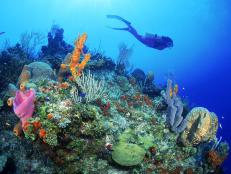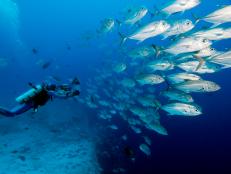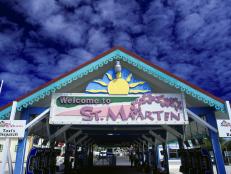Best Diving and Snorkeling in Belize

VitalyEdush, Getty Images
Tiny Belize’s mainland beckons with lush jungle canopy, palm-tangled Mayan ruins, and diverse wildlife. Still, this Central American jewel is best known for its snorkeling and diving sites along hundreds of cayes, atolls and a 185-mile barrier reef – second in size only to Australia’s. Abundant sea life and colorful corals fill the turquoise waters, are easily accessible and welcome divers and snorkelers of all experience levels. Dive tours can be half or whole days, with boat rides calm and usually under two hours. Other tour options include live-aboard boats, which offer week-long trips featuring 2 to 3 daily dives, including nighttime. From the busy north of Belize to the sleepy south, here are our choices for the best marine meanderings.
Hol Chan Marine Reserve and Shark-Ray Alley
Located in the north of Belize and visible from the southeastern shore of Ambergris, the country’s largest caye, Hol Chan and Shark-Ray Alley may be Belize’s most popular dive and snorkel spots. Crowds can be problematic, but at a mere 30 meters deep and with Finding Nemo-esque underwater views, the positives outweigh the negatives, especially for diving newbies and snorkelers.
Hol Chan opens to deeper waters beyond the reef, so divers and snorkelers will be greeted with an eruption of vibrant fish, nurse sharks, rays, turtles and the occasional dolphin. The eponymous sharks and rays are the site’s biggest attraction, and you’re guaranteed an adrenaline rush stroking the stippled hide of a nurse shark streaking by (but never touch the corals). Night dives reveal a completely different world of bioluminescence, glowing green moray eels and parrotfish dozing in protective mucus cocoons.
Caye Caulker
Also tucked away in northern waters, Caye Caulker is the relaxed cousin to tourist-prone Ambergris. Solid snorkeling and dive sites like Coral Gardens are short boat rides away, as is a manatee habitat. You’re not allowed to swim with these gentle mammals, but fear not -- this popular day trip typically includes snorkeling stops like Goff’s Caye and a visit to the waist-deep waters and wildlife at Shark Ray Village. Your guide may even point out delicate seahorses entwined in the mangroves.
Turneffe Islands
Turneffe is the largest of Belize’s 3 major offshore atoll reefs – (the next biggest are Glover’s and Lighthouse) and is lauded for its varied features: shallow reefs, wrecks and perhaps Belize’s most diverse sea life. More than 200 nearby mangrove islands are home to species like the endemic whitespotted toadfish, reef sharks, morays, turtles, dolphins, rays and jewfish. Even mantas and pelagic (open ocean-dwelling) fish like tuna and sailfish make an occasional visit. Fishing is limited here, so lobsters flourish. Visibility ranges from 100-150 feet, yet many divers enjoy intimate macrophotography opportunities. Snorkeling pleasures abound.
Most Turneffe dive sites are at the atoll’s southern end. Elbow is a popular stop for its large fish --giant groupers, mackerels, sharks and barracuda swim against a backdrop of soft corals. Sayonara is a 1985 passenger boat wreck now adorned with starfish and clams, and is an easy dive for novices. Though they are few, Belize’s other wreck sites include the barge Changa’s Wreck (Ambergris), steel freighter Myron L (Ambergris) and the remains of British naval cutter HMS Advice, sunk in 1793 (Turneffe).
Lighthouse Reef Atoll
Whether you want to see wildlife, walls, tunnels, corals, drift dives or the famed Great Blue Hole, dozens of Belize’s best dive sites are found at Lighthouse Reef, the farthest offshore atoll. One-day dive trips (snorkelers are welcome) hit hot spots like Aquarium, Silver Caves and Tres Cocos. Another site, Eagle Ray Wall features a shallow, colorful reef great for snorkelers, while divers can descend along the wall and capture excellent photos of eagle rays gliding by.
Centered on Lighthouse Reef, a trip to the Blue Hole is a feather in the cap of any experienced diver. A perfectly circular limestone sinkhole measuring 400 feet, the Hole’s caves, ledges and stalactites were studied by Jacques Cousteau. No finding Nemo here -- the site is known more for its geological formations than for fish-spotting, though hammerheads and other shark species do visit the hole’s circumference. The Blue Hole is not for novices -- veterans can briefly descend to 135 feet, and some outfitters may offer even shallower dives. If you do dive the Hole, go with a reputable company that is well-staffed with attentive dive masters.
Photo-friendly dives around the Half Moon Caye Wall follow shallow shelves populated with angelfish, sea fan corals and sponges into swim-throughs and deeper valleys frequented by nurse sharks, stingrays and pelagics. But the greatest wildlife-sightings may be on the white-sand caye itself, one of Belize’s best beaches. Some 4,000 red-footed booby birds can be found here in the protected Half Moon Caye Bird Sanctuary, along with frigate birds and turtle nesting sites.
Glover’s Reef Atoll
Belize’s southern reefs are less frequented by the many northern dive operators, so crowds are fewer and biology more diverse, especially coral growths. Long Caye Wall, with its sheer drop of more than 2,000 feet, was reputed to be Cousteau’s favorite dive site in Belize and is considered world-class snorkeling. Octopus Alley’s invertebrates and crustaceans make for lovely night dives. At Pinnacles, take in the 20- to 30-foot tall coral towers, the only ones in Belize according to Toby Truelove, a divemaster with Hamanasi Adventure and Dive Resort in Dangriga.
Truelove, also reveals a secret favorite site of his, the aptly-named Paradise, near tiny South Water Caye, east of Glover’s. The crevasses of Paradise’s double walls shelter goliath grouper, schools of horse-eyed jacks and Atlantic spade fish. Another worthwhile stop is the Abyss, a 300-foot straight cobalt drop often filled with eagle rays and turtles.
Gladden Spit
For an unforgettable and rare experience, visit Gladden Spit between March and June to dive with whale sharks. These harmless creatures are the largest species of fish and love feeding in the Southern Belize waters (east of Placencia). While not guaranteed, a shark sighting is probable for divers, and because whale sharks feed near the surface, even snorkelers can enjoy seeing them.








































